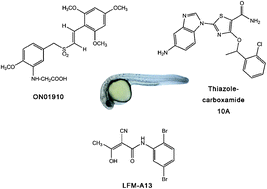Genetic approach to evaluate specificity of small molecule drug candidates inhibiting PLK1 using zebrafish†
Abstract
During the preclinical

* Corresponding authors
a Laboratory of Chemical Genomics, School of Chemical Biology and Biotechnology, Shenzhen Graduate School of Peking University, Shenzhen University Town, Shenzhen 518055, China
b
Department of Molecular, Cell, and Developmental Biology, University of California, Los Angeles, Los Angeles, USA
E-mail:
shuolin@ucla.edu
Fax: +1 310 2674970
Tel: +1 310 2674971
During the preclinical

 Please wait while we load your content...
Something went wrong. Try again?
Please wait while we load your content...
Something went wrong. Try again?
H. Zhong, S. Xin, Y. Zhao, J. Lu, S. Li, J. Gong, Z. Yang and S. Lin, Mol. BioSyst., 2010, 6, 1463 DOI: 10.1039/B919743E
To request permission to reproduce material from this article, please go to the Copyright Clearance Center request page.
If you are an author contributing to an RSC publication, you do not need to request permission provided correct acknowledgement is given.
If you are the author of this article, you do not need to request permission to reproduce figures and diagrams provided correct acknowledgement is given. If you want to reproduce the whole article in a third-party publication (excluding your thesis/dissertation for which permission is not required) please go to the Copyright Clearance Center request page.
Read more about how to correctly acknowledge RSC content.
 Fetching data from CrossRef.
Fetching data from CrossRef.
This may take some time to load.
Loading related content
